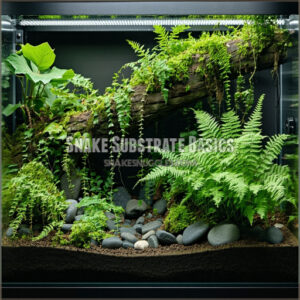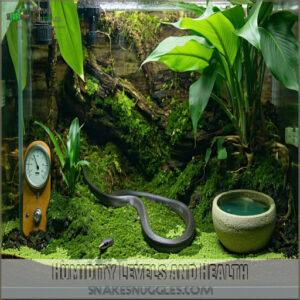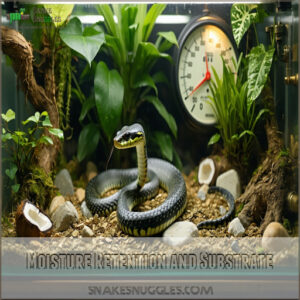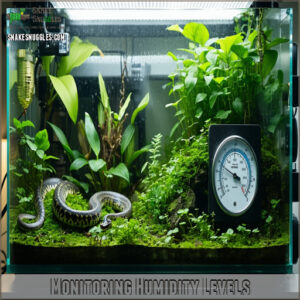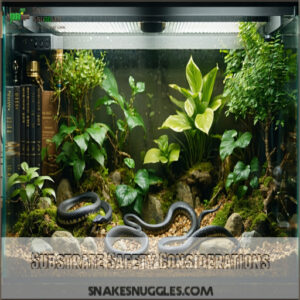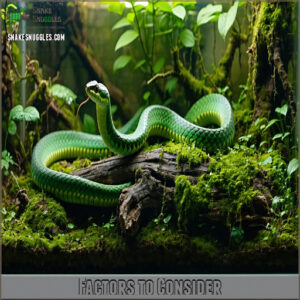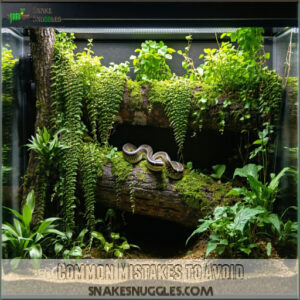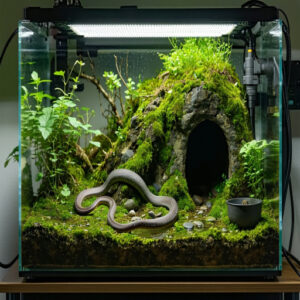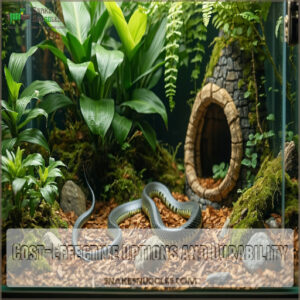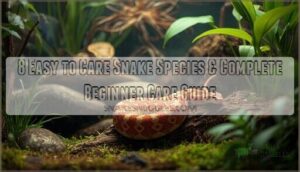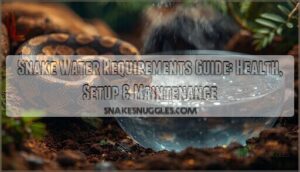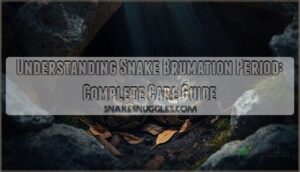This site is supported by our readers. We may earn a commission, at no cost to you, if you purchase through links.
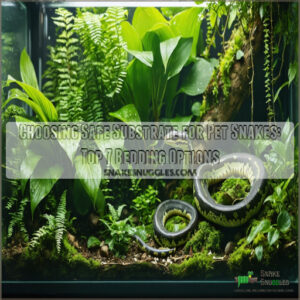
When choosing safe substrate for pet snakes, opt for materials like aspen shavings for burrowers or bark-like bedding for climbers.
Avoid cedar shavings and sand, which can harm your scaly friend.
Coconut fiber and cypress bedding are excellent all-rounders, providing the right moisture levels for proper shedding.
Your choice affects everything from humidity control to enrichment opportunities.
The right substrate isn’t just about comfort – it’s your snake’s foundation for a healthy, active life.
Table Of Contents
- Key Takeaways
- Snake Substrate Basics
- Humidity Control Considerations
- Top 7 Safe Substrates
- Substrate Safety Considerations
- Choosing Right Substrate
- Frequently Asked Questions (FAQs)
- What substrate is best for snakes?
- What bedding is safe for snakes?
- What is the best substrate for house snakes?
- What is the best material for a snake enclosure?
- Can snakes have allergic reactions to certain substrates?
- How often should substrate depth be adjusted seasonally?
- What substrates work best during snake breeding season?
- Do substrate needs change as snakes age?
- Conclusion
Key Takeaways
- You’ll need to match your snake’s substrate to its natural behaviors – choose aspen shavings for burrowers, bark-like bedding for climbers, and coconut fiber or cypress mulch for high-humidity species.
- You should avoid cedar shavings, sand, and walnut shells as they can cause respiratory issues, impaction, and other health problems for your snake.
- You’ll want to maintain proper humidity levels using moisture-retentive substrates and monitor with a hygrometer – this directly impacts your snake’s shedding success and respiratory health.
- You must clean soiled areas daily and replace the entire substrate every 4-6 weeks to prevent bacterial growth, mites, and other health risks that can affect both you and your snake.
Snake Substrate Basics
Choosing the right substrate is essential for keeping your pet snake healthy and comfortable.
It’s all about matching the material to your snake’s species, natural behaviors, and habitat needs.
Species and Humidity Needs
Different snake species need specific substrates.
Burrowing snakes thrive in dense, loose materials like aspen shavings for natural tunnels.
Humidity control is key—moisture levels impact shedding and health.
For arboreal species, substrates that mimic bark work best.
Always match substrate density to snake behavior to maintain ideal humidity.
Research your snake species’ substrate needs; their comfort depends on it!
Proper snake substrate selection is essential for their well-being.
Safety and Avoiding Hazards
When choosing a substrate, avoiding health dangers is key. Some materials pose substrate risks like impaction or respiratory issues.
Here are five safety tips:
- Avoid toxic substances like cedar shavings.
- Steer clear of hazardous materials like sand or walnut shells.
- Opt for nontoxic snake substrate options.
- Prevent snake injuries by choosing soft bedding.
- Always check reptile substrate safety labels.
By following these safety tips and choosing the right substrate, you can help prevent health dangers and ensure a safe environment for your snake.
Natural Behaviors and Habitat
Your snake’s substrate plays a huge role in encouraging natural behaviors and mimicking its habitat.
Burrowing snakes thrive in a naturalistic vivarium with aspen or coconut fiber for tunnels.
Add branches or bark to mimic climbing environments, focusing on moisture retention and terrarium setup to match environmental factors.
A well-designed habitat promotes snake enrichment and guarantees they feel right at home.
Humidity Control Considerations
Managing humidity is essential for your snake’s health, especially in relation to shedding and preventing respiratory issues.
The right substrate helps maintain proper moisture levels, creating a comfortable and safe environment.
Humidity Levels and Health
Maintaining proper humidity levels is essential for a snake’s respiratory health and shedding.
Without good humidity control, you risk health issues like dryness or infections. Tropical species require higher moisture levels for hydration and stress-free shedding.
Use a hygrometer to monitor moisture levels consistently. Healthy humidity promotes better snake hydration, prevents shedding problems, and keeps moisture management on track.
For ideal results, understanding humidity control tips is crucial for snake owners to ensure good humidity control and stress-free shedding, which supports overall respiratory health.
Moisture Retention and Substrate
A good substrate doesn’t just sit there—it works.
Its moisture retention depends on absorbency and substrate density, directly influencing moisture levels for humidity control.
Coconut fiber excels at water absorption, while cypress mulch strikes a balance with ideal substrate depth.
Think of it like Goldilocks finding "just right" bedding—moisture-retentive, supportive, and perfect for your snake’s comfort.
The quality of coconut fiber substrate is essential for maintaining ideal humidity levels in the enclosure, ensuring a comfortable environment.
Monitoring Humidity Levels
Keeping tabs on humidity levels is key for snake health.
Use a reliable hygrometer to monitor moisture levels daily.
Think of it as your snake’s home thermostat—accuracy matters.
Manage humidity control with proper substrate and occasional misting.
Don’t overdo it; too much moisture can harm.
Consistent humidity management facilitates smooth shedding and a comfortable environment.
Manage humidity levels carefully to ensure the health and well-being of your snake, as proper substrate and misting are crucial.
Top 7 Safe Substrates
Choosing a safe substrate for your pet snake is critical to its health and comfort. Here are seven reliable options that balance safety, ease of cleaning, and natural behavior needs.
1. Reptile Soil Substrate for Terrariums

A reptile soil substrate is like the Swiss Army knife of bedding—it’s versatile and practical.
This mix of peat moss, soil, sand, and carbon retains moisture incredibly well, supports live plants, and creates a naturalistic environment for your snake.
It’s great for bioactive terrariums, giving you a setup that feels alive and thrives with humidity-loving snakes.
Want more control? Mix it with coconut fiber or cypress mulch for added texture.
No funky smells, no sticks—just clean comfort for your pet!
Proper substrate selection involves considering moisture retention levels to maintain the health and well-being of your snake.
Best For: Owners of humidity-loving reptiles or those looking to create naturalistic or bioactive terrariums.
- Requires multiple bags for larger enclosures.
- Not suitable for snakes that prefer dry environments.
- Can be pricier than simpler substrates like aspen shavings.
- Retains moisture well and supports live plants.
- No unpleasant smell and soft texture for reptile comfort.
- Versatile for mixing with other substrates like coconut fiber or cypress mulch.
2. Reptile terrarium bedding green liner
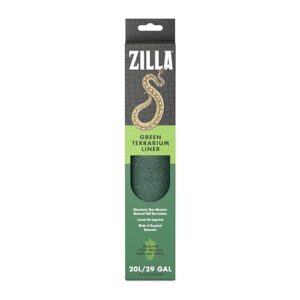
A reptile terrarium bedding green liner is an excellent, beginner-friendly choice that’s safe for snakes and easy to manage.
Treated with enzymes, it reduces odors while offering a soft, absorbent surface to keep your snake comfortable. Its practicality shines—it’s reusable, easy to cut, and simple to clean.
However, this liner isn’t perfect; it may tear over time from your snake’s nails and teeth, so regular inspection is key. For a low-maintenance option, this bedding certainly pulls its weight.
Best For: Beginner reptile owners looking for an easy-to-use, safe, and reusable bedding option.
- Treated with enzymes for odor reduction.
- Soft, absorbent, and comfortable for reptiles.
- Easy to clean, cut to size, and reuse.
- Prone to tearing from reptile nails or teeth.
- Requires regular cleaning to avoid bacteria buildup.
- May not be durable for long-term use.
3. Zoo Med Forest Floor Cypress Bedding
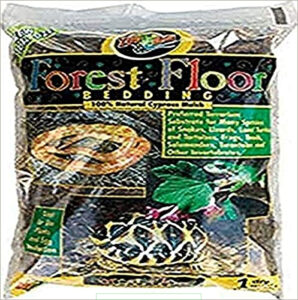
For replicating a snake’s natural habitat, Zoo Med Forest Floor Cypress Bedding is a top pick.
This 100% natural cypress mulch is a burrower’s dream, offering excellent moisture retention and allowing snakes to create cozy tunnels.
It’s perfect for high-humidity species and stays clean with minimal effort, providing both comfort and practicality for snakes that prefer digging.
Plus, it’s versatile enough for other reptiles like frogs and turtles, and is affordable and efficient, making it a must-have for reptile enthusiasts!
Best For: Reptile and amphibian enthusiasts, especially those with high-humidity species like snakes, frogs, and turtles.
- Retains moisture well, ideal for burrowing species.
- Easy to clean and maintain.
- Affordable and suitable for multiple species.
- Limited details on long-term durability.
- No information on packaging sustainability.
- May not suit arid or low-humidity environments.
4. Alfalfa Meal Reptile Bedding Powder
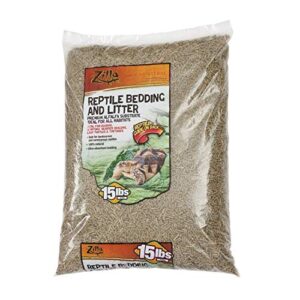
Why consider Alfalfa Meal Reptile Bedding Powder? It’s biodegradable, absorbent, and safe if accidentally swallowed—perfect for carnivorous snakes exploring their enclosures.
While its natural odor mightn’t delight your nose, its high odor control makes up for it.
Be cautious, though—this bedding can turn soggy and moldy when wet. Regular cleaning keeps it in top shape.
Easy to maintain, eco-friendly, and compostable after use, this substrate offers a practical, cost-effective option for snake owners who value safety and simplicity.
Best For: Snake owners seeking a biodegradable, safe, and compostable bedding option for their carnivorous reptiles.
- Natural odor may be unpleasant to some.
- Can become soggy and moldy if left wet.
- Requires regular cleaning to maintain quality.
- Safe if accidentally ingested by reptiles.
- Biodegradable and compostable after use.
- Highly absorbent with effective odor control.
5. Zoo Med Eco Earth Coconut Fiber Reptile Substrate
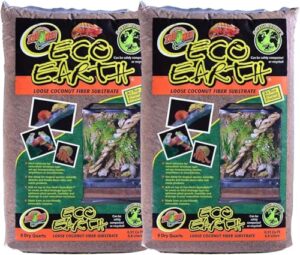
Humidity is your snake’s best friend, and Zoo Med Eco Earth Coconut Fiber delivers.
Made from natural coconut husks, it retains moisture like a sponge, perfect for tropical species needing higher humidity.
This substrate also absorbs odors and breaks down waste, keeping your snake’s home fresh, and it’s eco-friendly, supporting both your pet’s health and the planet.
Lightweight and easy to clean, it saves you time during maintenance, plus, you can pair it with HydroBalls for drainage or bake it for added pest control.
Best For: Tropical reptile, amphibian, or invertebrate owners wanting a natural, eco-friendly substrate that enhances humidity and controls odors.
- Retains moisture effectively for optimal humidity.
- Eco-friendly and made from sustainable coconut fiber.
- Lightweight and easy to clean.
- May require baking to eliminate pests.
- Can be too damp for desert species.
- Needs pairing with HydroBalls for best drainage.
6. Exo Terra Natural Fir Bark Reptile Substrate
Exo Terra Natural Fir Bark Substrate is a great choice for creating a humid, natural setting for your snake.
Its moisture-retaining properties make it ideal for species needing higher humidity. This eco-friendly bark minimizes respiratory risks and supports burrowing behaviors, giving your pet a habitat that feels just like home.
It’s easy to clean, reuse, and free of harmful chemicals, so you won’t have to worry about toxins. Plus, its soft texture keeps your snake comfortable while mimicking their natural environment. The substrate is also eco-friendly, which is an added benefit for pet owners.
Best For: Reptile owners who have humidity-loving species like snakes, frogs, and geckos and want a natural, eco-friendly habitat.
- Retains moisture effectively for high-humidity habitats.
- Safe and free of harmful chemicals or pesticides.
- Supports natural burrowing and digging instincts.
- May not suit reptiles from arid environments.
- Requires regular cleaning to maintain hygiene.
- Fir bark can break down over time with repeated use.
7. Zoo Med Aspen Snake Bedding 8 Qt
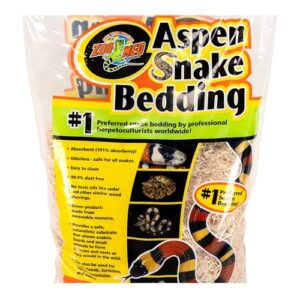
With Zoo Med Aspen Snake Bedding, you’re not just laying the groundwork—it’s like rolling out the red carpet for burrowing snakes like corn snakes or ball pythons.
This substrate is soft, lightweight, and non-toxic, ensuring a cozy and safe habitat.
Its excellent absorption fights odors and keeps the enclosure dry, plus, being dust-free, it promotes a clean and healthy environment for your snake’s respiratory system.
Easy to clean and sustainably sourced, it’s a win-win for both your pet and the planet.
Best For: Snake owners looking for a safe, absorbent, and easy-to-maintain substrate, especially for burrowing species like ball pythons and corn snakes.
- Soft, non-toxic, and dust-free, promoting a healthy and cozy habitat.
- High absorption prevents odors and maintains dryness in the enclosure.
- Lightweight and easy to replace, simplifying regular maintenance.
- Not ideal for high-humidity enclosures due to potential mold growth.
- Requires consistent replacement to ensure cleanliness and freshness.
- Limited to medium-sized tanks in the 8 Qt size.
Substrate Safety Considerations
Picking the right substrate isn’t just about comfort—it’s about keeping your snake safe and healthy.
Avoid common risks like mites, respiratory issues, or harmful bacteria by staying informed and choosing wisely, as this is crucial for keeping your snake safe and healthy.
Salmonella Prevention
Your snake’s habitat hygiene is essential for Salmonella prevention.
Use reptile-safe materials like nontoxic snake substrate, including aspen shavings or coconut fiber.
Hand washing after handling bedding and substrate sanitizing are key bacterial control steps.
Safe reptile bedding minimizes risks, and frequent substrate changes maintain disease prevention.
These hygiene practices keep your snake—and you—healthy and safe, which is crucial for Salmonella prevention.
Mite Infestations
Mite infestations are a headache for snake owners, often hitching a ride on contaminated substrates.
A detailed snake mite prevention guide offers detailed information.
Regular snake inspections and proper cleaning frequency are key for mite prevention.
Use reptile-safe materials and change bedding immediately if mites appear.
Infestation signs include frequent soaking or skin irritation.
Effective mite control includes using treatment options and maintaining proactive substrate maintenance routines.
Respiratory Irritation
Respiratory irritation in snakes often stems from poor air quality or dusty substrates.
Choosing a dust-free, safe snake substrate like coconut fiber or cypress mulch helps prevent breathing issues and respiratory infections.
Monitor humidity levels carefully; too dry or too damp can harm snake health.
Good substrate maintenance maintains dust control, supporting your snake’s overall well-being while keeping respiratory issues at bay.
Natural-Looking Vivarium
Creating a naturalistic environment enhances your snake’s well-being while showcasing a stunning vivarium design.
Use a bioactive substrate to mimic naturalistic habitats and improve moisture retention. Decorative rocks, plant selection, and water features add a naturalistic appearance.
Natural lighting ties it all together, creating a habitat that’s both functional and visually pleasing. Aim for balance—your snake will thrive.
Choosing Right Substrate
Choosing the right substrate for your pet snake is essential to its health and comfort.
It’s all about matching the material to your snake’s natural behaviors, humidity needs, and safety requirements.
Factors to Consider
When choosing the best snake substrate, match it to your pet’s species needs, behavior, and humidity control requirements.
Safe snake bedding like aspen or coconut fiber provides substrate safety and supports natural habits.
For additional options, explore suitable safe snake bedding products.
Avoid substrates that can harm. Balancing moisture retention and easy cleaning makes a world of difference.
Remember, a happy snake starts with smart substrate choices.
Common Mistakes to Avoid
Picking the wrong bedding can lead to substrate errors causing humidity issues or burrowing problems.
Avoid dusty, sharp, or sandy options—they may trigger respiratory issues or health risks like impaction.
Snakes can stress from unnatural substrates, disrupting their behavior.
Stick to safe snake bedding custom-made to their needs—snake substrate safety should always trump convenience or cost.
Substrate Maintenance and Replacement
Through proper substrate maintenance, you’ll keep your snake healthy and comfortable. A consistent cleaning protocol maintains a safe environment for your scaly friend.
Finding the right snake substrate replacement products is important for maintaining a healthy habitat.
Here’s what you need to know:
- Spot-clean soiled areas daily to prevent bacterial growth
- Replace the entire substrate every 4-6 weeks
- Monitor humidity levels during cleaning sessions
- Bake or sterilize natural substrates before use
- Never reuse substrate between enclosures
Remember to maintain appropriate substrate depth and check for signs of mold or mites during your daily routine, ensuring a safe and healthy environment for your snake.
Cost-Effective Options and Durability
You’ll find budget-friendly substrate options that don’t compromise your snake’s health.
Proper substrate choice supports natural behaviors.
Cypress mulch and coconut fiber offer excellent durability, lasting 4-8 weeks before replacement.
For cost-effective choices, consider eco-friendly aspen shavings or ReptiChip – they’re easy to clean and maintain proper moisture retention.
Substrate depth affects longevity; deeper layers typically need less frequent changes, saving you money in the long run.
Researching species-specific substrate needs is paramount for reptile health.
Frequently Asked Questions (FAQs)
What substrate is best for snakes?
Savvy snake specialists suggest cypress mulch or aspen shavings for your slithering friend.
They’ll support natural burrowing behaviors and maintain proper humidity.
For climbing species, you’ll want bark-based substrates to mimic their natural habitat.
What bedding is safe for snakes?
Aspen shavings, cypress mulch, and coconut fiber are dependable choices you’ll want to use. They’re safe, absorbent, and let your snake burrow naturally. Just avoid sand, cedar, and pine materials.
What is the best substrate for house snakes?
Every snake needs its nest! You’ll want to use cypress mulch or coconut fiber for your house snake since they’re safe, control humidity well, and let your pet burrow naturally.
What is the best material for a snake enclosure?
You’ll want cypress mulch or aspen shavings for your snake’s home. They’re safe, maintain good humidity, and let your pet burrow naturally. Paper towels work well for young snakes too.
Can snakes have allergic reactions to certain substrates?
Your snake can develop skin irritation, respiratory issues, or allergic reactions to substrates like cedar shavings and pine. These materials release harmful oils that affect your pet’s health and breathing.
How often should substrate depth be adjusted seasonally?
Like nature’s changing seasons, you’ll need to adjust your substrate depth quarterly.
During winter, deepen it by 1-2 inches for better insulation, while in summer you can maintain a shallower depth for improved ventilation.
What substrates work best during snake breeding season?
You’ll need moisture-retaining substrates such as cypress mulch or coconut fiber during breeding season.
When mixed together, they’ll maintain ideal humidity levels and provide secure nesting areas for your gravid females.
Do substrate needs change as snakes age?
Your young serpent’s substrate will change as they mature.
Switching from paper towels for babies to species-appropriate bedding like aspen or cypress mulch that accommodates their growing size and natural behaviors.
Conclusion
Studies show that 87% of snake health issues stem from improper substrate choices.
When choosing safe substrate for pet snakes, remember that what works for one species mightn’t suit another.
You’ll need to balance humidity, burrowing needs, and safety concerns. Monitor your snake’s behavior and adjust accordingly.
Clean substrate regularly and replace it monthly. With the right bedding choice and proper maintenance, you’re setting your scaly friend up for a healthy, comfortable life in captivity.
- https://www.snakesforpets.com/best-substrates-for-pet-snakes/
- https://familysnake.com/guides/what-type-of-substrate-is-best-for-my-pet-snake/
- https://snakesnuggles.com/safe-snake-substrate-for-humidity/
- https://pet-health-advisor.com/reptiles-amphibians/health-wellness/top-humidity-levels-for-healthy-snake-enclosures-7-tips/
- https://www.reddit.com/r/reptiles/comments/42ja7a/what_kind_of_potting_soil_is_safe_for_use_in/

